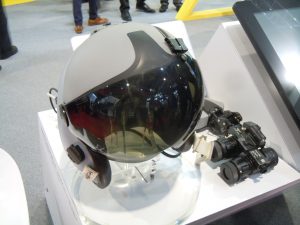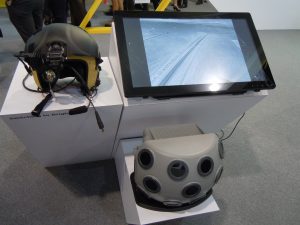Elbit Systems: JHMCS II and the BrightNite system
By David Oliver
Elbit’s Joint Helmet-Mounted Cueing System (JHMCS) provides the pilot with “first look, first shoot” high off-boresight weapons engagement capabilities. Through Rockwell Collins ESA Vision Systems (RCEVS), most frontline US fighters including F-15, F-16 and F/A-18 are being equipped with the JHMCS, which is currently operationally proven in over 20 air forces worldwide.

Built on an exceptional legacy of operational success, the new JHMCS II offers uniquely advanced capabilities in an affordable package. JHMCS II is lightweight, with minimal installation footprint, delivering new levels of logistics and operational savings. Among its significant features is night symbology (NVCD) and click-on night vision goggles (NVG) with a 20-degree field of vision (FOV) utilising the standard NVG mounting bracket
The system provides high accuracy, hybrid optical/inertial tracker with unlimited motion box and high redundancy and multi-sensor video presentation. It also has a virtual training display support
JHMCS II can be integrated with Canary, a breakthrough solution, capable of identifying and warning prior to hypoxia and GLOC events or call for automatic aircraft recovery in case of the pilot’s loss of consciousness. JHMCS will be used in the Brazilian Gripen E/F aircraft now in production.
Under development is the Digital JHMCS (D-JHMCS) that offers advanced capabilities in an affordable package in addition to the legacy features of the JHMCS II. The new D-JHMCS delivers advanced video and colour capabilities both for day and night missions via a low voltage flat field projector.
Also showcased for the first time in an Asian defence show is the BrightNite system that enables intuitive head-up, eyes-out orientation flight by helicopters in extreme low visibility conditions. This system is a multi-spectral end to end panoramic piloting solution that fuses multiple day and night cameras into one clear intuitive piloting picture regardless of outer light conditions and delivers the landscape scenery directly to both eyes of the pilot, including flight, mission and brownout symbology.

Leaving behind the classic dependency on NVGs only, the BrightNite system uses an uncooled FLIR sensor fused by a multi-spectral synthetic vision (SVS) and colour conformal 3D mission symboloy. An ultra-wide field of regard display brings together the best of visual and synthetic panoramic vision to allow all aircrew members to be surrounded with a daylight-like picture from all angles.
BrightNite is designed to support stealth operations in all night and low visibility conditions, overcome ‘brownout’, ‘whiteout’ and ‘sprayout’ conditions. The system integrates with missile warning systems and complies with leading helmet display and tracking system (HDTS-ANVIS/HUD).
